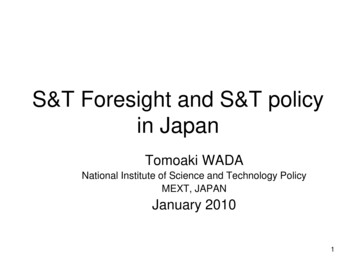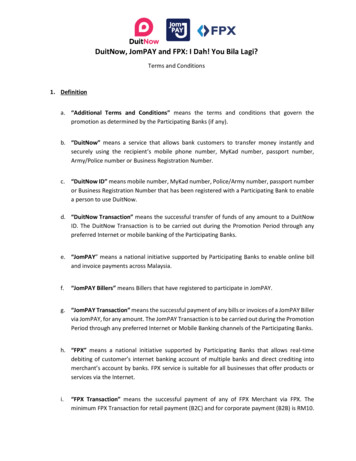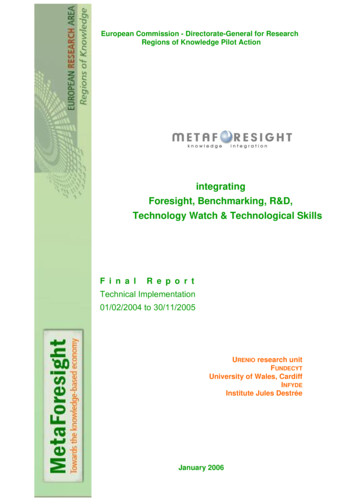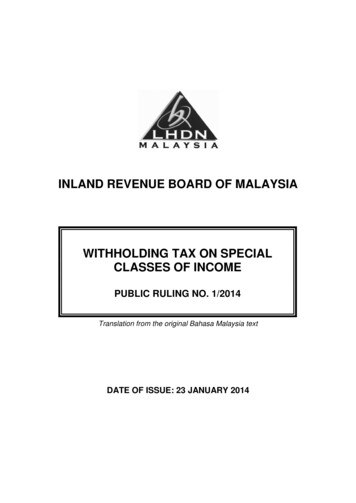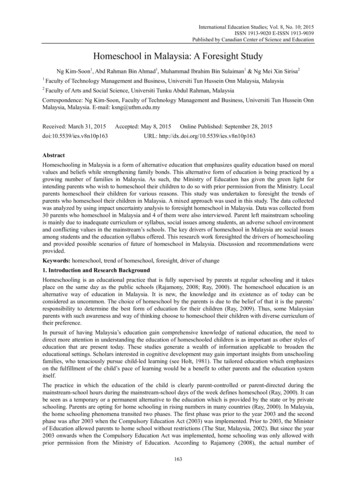
Transcription
International Education Studies; Vol. 8, No. 10; 2015ISSN 1913-9020 E-ISSN 1913-9039Published by Canadian Center of Science and EducationHomeschool in Malaysia: A Foresight StudyNg Kim-Soon1, Abd Rahman Bin Ahmad1, Muhammad Ibrahim Bin Sulaiman1 & Ng Mei Xin Sirisa21Faculty of Technology Management and Business, Universiti Tun Hussein Onn Malaysia, Malaysia2Faculty of Arts and Social Science, Universiti Tunku Abdul Rahman, MalaysiaCorrespondence: Ng Kim-Soon, Faculty of Technology Management and Business, Universiti Tun Hussein OnnMalaysia, Malaysia. E-mail: ksng@uthm.edu.myReceived: March 31, 2015doi:10.5539/ies.v8n10p163Accepted: May 8, 2015Online Published: September 28, 2015URL: eschooling in Malaysia is a form of alternative education that emphasizes quality education based on moralvalues and beliefs while strengthening family bonds. This alternative form of education is being practiced by agrowing number of families in Malaysia. As such, the Ministry of Education has given the green light forintending parents who wish to homeschool their children to do so with prior permission from the Ministry. Localparents homeschool their children for various reasons. This study was undertaken to foresight the trends ofparents who homeschool their children in Malaysia. A mixed approach was used in this study. The data collectedwas analyzed by using impact uncertainty analysis to foresight homeschool in Malaysia. Data was collected from30 parents who homeschool in Malaysia and 4 of them were also interviewed. Parent left mainstream schoolingis mainly due to inadequate curriculum or syllabus, social issues among students, an adverse school environmentand conflicting values in the mainstream’s schools. The key drivers of homeschool in Malaysia are social issuesamong students and the education syllabus offered. This research work foresighted the drivers of homeschoolingand provided possible scenarios of future of homeschool in Malaysia. Discussion and recommendations wereprovided.Keywords: homeschool, trend of homeschool, foresight, driver of change1. Introduction and Research BackgroundHomeschooling is an educational practice that is fully supervised by parents at regular schooling and it takesplace on the same day as the public schools (Rajamony, 2008; Ray, 2000). The homeschool education is analternative way of education in Malaysia. It is new, the knowledge and its existence as of today can beconsidered as uncommon. The choice of homeschool by the parents is due to the belief of that it is the parents’responsibility to determine the best form of education for their children (Ray, 2009). Thus, some Malaysianparents with such awareness and way of thinking choose to homeschool their children with diverse curriculum oftheir preference.In pursuit of having Malaysia’s education gain comprehensive knowledge of national education, the need todirect more attention in understanding the education of homeschooled children is as important as other styles ofeducation that are present today. These studies generate a wealth of information applicable to broaden theeducational settings. Scholars interested in cognitive development may gain important insights from unschoolingfamilies, who tenaciously pursue child-led learning (see Holt, 1981). The tailored education which emphasizeson the fulfillment of the child’s pace of learning would be a benefit to other parents and the education systemitself.The practice in which the education of the child is clearly parent-controlled or parent-directed during themainstream-school hours during the mainstream-school days of the week defines homeschool (Ray, 2000). It canbe seen as a temporary or a permanent alternative to the education which is provided by the state or by privateschooling. Parents are opting for home schooling in rising numbers in many countries (Ray, 2000). In Malaysia,the home schooling phenomena transited two phases. The first phase was prior to the year 2003 and the secondphase was after 2003 when the Compulsory Education Act (2003) was implemented. Prior to 2003, the Ministerof Education allowed parents to home school without restrictions (The Star, Malaysia, 2002). But since the year2003 onwards when the Compulsory Education Act was implemented, home schooling was only allowed withprior permission from the Ministry of Education. According to Rajamony (2008), the actual number of163
www.ccsenet.org/iesInternational Education StudiesVol. 8, No. 10; 2015homeschoolers in Malaysia is less than the number of the approved homeschoolers by the Ministry of Education.Home schooling involves the use of a self-determined curriculum. The curriculum may be bought off the shelf orone the parent build it up by combining the best from available syllabuses. The curriculum may be selectedbased on religious inclinations or pedagogical reasons (Basham, 2001). The internet, personal computertechnology and the readily available resources including support groups and educational material have madehome schooling easier (Aurini & Davies, 2005; Basham et al., 2007). With internet and online chatting, thehomeschooling parents are able to establish their own circles, homeschooling websites, forums, etc. (He, 2012).They gathered together on Internet, sharing homeschooling resources, organizing online discussions amongparents. They also held off-line activities for parents and homeschooling children. However, despite all thesedelighted developments of homeschooling, in China there has not been a single specific regulation forhomeschooling, or any official organizations or supportive group so far (He, 2012). Home schooling allowsinnovative learning options. In Alaska, teachers in Juneau work with students located at all over the state, stayingin touch by mail, telephone, and through occasional home visits. In California, children can enroll in anindependent-study program through a public school then base their studies in their own homes. Washington andIowa require public schools to enroll children on a part-time basis if they apply (Lines, 1995).Homeschool is a choice among parents, although it is an alternative and not a mainstream education in Malaysia.It is still growing with all kind of syllabus and curricular module brought into Malaysia by homeschooler’sparents and private schools that offer homeschool education. The number of parents’ homeschooling in Malaysiais close to 5,000 children (Bajunid, 2002). This number is still growing as issues of mishandle of students cases,social problem in mainstream school, inefficiency in teaching and learning and practice in the mainstream schoolthat is not aligned with the family’s belief has led to the increase of homeschool population in Malaysia.Although the homeschooling trend is growing in popularity in the United States, there is lacking of empiricalresearch work focusing in the area (Green & Hoover-Dempsey, 2007). Reviews on previous literatures show thatthere are scant number of studies that focus on homeschool in Malaysia. Homeschool being quite newphenomena in Malaysia and in this case, there seems to be a need for a clear understanding and to be explored.Underlying issues here include the unclear direction of homeschool in Malaysia. What is driving thehomeschooling trend and how is it being perceived in Malaysia? Research questions of this study are: 1. What isthe trend of homeschooling in Malaysia? 2. What are the homeschool drivers of change and the perceptionstowards national education system? 3. What will be the future trend of homeschooling in Malaysia by the year2025? It follows that the research objectives of this study are: 1) To study the trend of homeschooling inMalaysia. 2) To study the homeschool drivers of change and perception towards national education system and;3) To study the future trend of homeschooling in Malaysia by the year 2025.This research is a foresight case of homeschool trends in Malaysia by the year 2025. And it will determine theimpact of homeschool to the students and the driving factors of continuous choice of homeschool education in afamily. Since there are limited number of studies that focus on homeschool in Malaysia with lack of study onforesight of it, this study can provide some contribution in term of additional knowledge of this subject in theMalaysian context. The lack of study on this matter would be invaluable as the advantage and disadvantage ofhomeschool especially for Malaysians in a multicultural environment would substantially cover the issues oftoday’s Malaysian parents’ preference in education of our future generations. Thus, this foresight study isforeseen to engage in these new phenomena in Malaysia’s education and to aid the responsible parties in theirdebate of direction of homeschool education. The respondents are the family that home school their children.This specific group of parents have high influence of society. They include bloggers and also parents who hadstudied abroad and are able to compare the different ways and style of education offered. In Malaysia, majorityof the home schoolers exist in Kuala Lumpur. Thus, in this study, the respondents are from Kuala Lumpur.2. Literature ReviewThe importance of the direction of homeschool in Malaysia and any other countries are crucial to be studied as itis the guidelines of where and when the homeschooler could improvise for the sake of their children’s educationin the future.The education system in Malaysia formally involves nine types of schools namely national schools, national typeschools, religious schools, school preacher, a typical model school, a typical school education, vocational andtechnical schools, and full boarding school (Ministry of Education, 2010). The education system in Malaysia isdynamic along with the development and progress of the age. Education in Malaysia is overseen by onegovernment ministry. The Ministry of Education handles matters pertaining to pre-school, primary school,secondary school, post-secondary school and tertiary education.164
www.ccsenet.org/iesInternational Education StudiesVol. 8, No. 10; 2015Although education is the responsibility of the federal government, each state has an Education Department tocoordinate educational matters in its territory. The main legislation governing education is the Education Act of1996. Primary public education in Malaysia begins at age seven in National or Vernaculars Primary Schools andlasts for six years, referred to as Year 1 to 6. Year 1 to Year 3 are classified as Level One while Year 4 to Year 6are considered as Level Two. Students are promoted to the next year regardless of their academic performance.Public secondary education in Malaysia is provided by National Secondary Schools. The National SecondarySchools use Malay as the main medium of instruction. English is a compulsory subject in all schools. Since 2003,Science and Mathematics had been taught in English, however in 2009 the government decided to revert to usingMalay starting from the year 2012. After the SPM (Malaysian School Certificate of Education), students frompublic secondary school would have a choice of either studying Form 6, Foundation in Science or Arts forentrance to University in private university or the matriculation (pre-university). If they are accepted to continuestudying in Form 6, they will also take the Sijil Tinggi Persekolahan Malaysia (which is usually called as STPM)or Malaysian Higher School Certificate examination (its British equivalent is the General Certificate ofEducation ‘A’ Levels examination or internationally, the Higher School Certificate). SPM and STPM areregulated by the Malaysian Examinations Council.Homeschooling is an educational practice that is fully supervised by parents at regular schooling and took placeon the same day as the public schools (Rajamony, 2008; Ray, 2000). Parents choose to engage in homeschoolbecause they want to educate and monitor their children with their own reference. At the same time they do notmarginalize academic excellence to continue the survival of their children to meet the demands of society ingaining employment. Selection of an appropriate curriculum could be compassed by religious inclination oraspects of pedagogy (Rajamony, 2008). Parents asserted that it is their responsibility to determine the best formof education for their children, and not the responsibility of other parties (Ray, 2009).The choice narrated by parents who homeschooled their children were classified and noted by two elements ofstyles, the pedagogy, which can be simplified as earth based or science based, and ideologues which also can besimplified as heaven based or religion based (see Van Galen, 1988). It diverts nationwide research works basedon these two opposite teaching factors and styles. Homeschooling parents appeared to be strongly motivated bypersonal motivators identified in the general parental involvement literature, such as an active role constructionand a strong sense of efficacy for helping the child learn, than by other explanations for homeschooling, such asparents’ beliefs about the values, content, adequacy, and methods of public school education (see Ice &Hoover-Dempsey, 2010). Most of the fundamental homeschoolers that set the essence of homeschooling werefundamentalist Christian, which also can be classified as religion as core in one’s way of educating, (Ray, 1997;Van Galen, 1988) as they observe the clearance of giving the nature of obedience to Lord preach biblically.Homeschooling allows parents from all of these groups to integrate their particular religious beliefs into theirchildren’s educations (Ray, 1997; Rudner, 1999; Van Galen, 1988).Rajamony (2008) conducted a qualitative study of five Malaysian families who homeschooled their children.The findings showed that parents choose to homeschool them due to the content of the public school curriculumwhich is not convincing enough. Parents were also concerned about what they saw as inefficiency in teachingand learning and practice in the mainstream school that is not aligned with the family’s belief.Studies of diverse groups of elementary and middle school students have suggested that role activity beliefs doinfluence parents’ decisions about becoming and being involved in their children’s education involvement (e.g.,Chrispeels & Rivero, 2001; Drummond & Stipek, 2004; Grolnick et al., 1997; Hoover-Dempsey et al., 2005;Sheldon, 2002). Green and Hoover-Dempsey (2007), for example, reported that most homeschool parents hadparticularly strong role activity beliefs related to involvement in their children’s education. Children’s interest inlearning for their own sakes, in contrast with learning for the external consequences or rewards it may yield(Ryan & Deci, 2000). This triggers the interest of parents to experiment on how to push and mold their childrento their full potential. This would result in shaping of inner self and distinct characteristic rather than what themainstream education could offer to the children in their growing phase.The latest issues related with homeschool in the period of 2008 till 2014 include parents motivation (Walter et al.,2011), the increasing numbers of homeschoolers (Ray, 2011), hesitation on homeschool (Haugh, 2014),homeschool comprehensive study (Kunzman & Gaither, 2013) and fundamental challenge (Ross, 2010). Thesetopics were popular and discussed.There is an increasing numbers of children being homeschooled (Lines, 2000; Russo, 1999; Stevens, 2001). Theincrease reflects a growing dissatisfaction with formal education (Lyman, 1998) and a growing public acceptanceof homeschooling (Lines, 2000). Homeschooling is growing in popularity in the United States (e.g., up from165
www.ccsenet.org/iesInternational Education StudiesVol. 8, No. 10; 2015850,000 students, or 1.7% of K-12 students in 1999–Bielick et al. (2001)–to 1.1 million students, or 2.2% ofK-12 students in 2003–Princiotta et al., 2004). In the United States, homeschooling had been legalized since theyear 1993 in all 50 states under the pressure from homeschooling organizations. The exact numbers of homeeducators in each country are difficult to come by for a variety of reasons. In some countries, children who havenever been to school are not required to register with the authorities.In the United States, the study of ins and outs journal emphasized that the homeschool implemented consisted oftwo crucial factors. The ins is the motivation from the parents that homeschool and the outs is the level ofachievement of the homeschool students. This study showed details of Parents’ motivations for homeschoolingare not uniformly affected by their education, gender, income, marital status, previous involvement withhomeschooling, or political identification. While the results for the outs or the achievements were higher inaccordance to several factor which were related to the level of education of the parents, the political view orstands and the type of motivation that drive them to homeschool (see Collom, 2005). Parents that homeschool inU.S were related for having a high level of education or highly educated than parents of non-homeschoolers.Parents gave a wide variety of reasons for homeschooling their children. These reasons included being able togive their child a better education at home, for religious reasons, and because of a poor learning environment atschool. Most research works in the past are on determining the whys of parents homeschool their children (see B.Boschee & F. Boschee, 2011). Study shown that the choice of homeschool among parents are linked with the factthat most homeschoolers achieved better results in their entrance examination and test which ultimately broughtthem to enter known college and strive afterwards.The common cause of homeschooling from its history was related with religion as studies shows that theawareness of religion in molding their offspring to have the religion essence which these parents are afraid oftheir children lack of it or not be learned as they were before. Thus, the idea of controlling of what to be taughtwhich would satisfy them technically that the mainstream education offered from the government in theircountry. In this way, parents are protecting their rights to give as much religion based education. Example,Muslim turns to homeschool in order to protect their children from drug using and also their daughters from badimage dresses, the bad talk or swearing, and low respects level to their elders, as well to give protection fromupcoming prejudice (MacFarquhar, 2008). These parents feel that traditional schools, especially mainstreamschools, fail to teach the importance and the respect their families’ values and that these schools sometimes lackand lost in its module or curricula which in their opinion contradict with their belief (Ray, 1997; Rudner, 1999;Van Galen, 1988). Thus, the idea of confronting the social problems which were drugs, sexual activity, and alsosexual orientation to be covered by the hand of the parents, which brought to way of homeschool in order toprotect their children in this fast changing world. Zhao and Badzis (2014) reported that in mainland China,parents who are motivated to choose homeschool are basically out of concerns and dissatisfied with theireducational systems which is exam-oriented and others due to religion reason. A large group ofpedagogically-oriented parents chooses homeschooling to avoid the hegemonic and inequitable facets oftraditional schools. Schools, such parents contend, legitimize certain knowledge and cultures while excludingothers (Van Galen, 1988). The idea of building or nurturing their children to be their true self rather than let thepublic school rank and standardize their children, which worries them as so they feel traditional schools fail toencourage independent thinking (Franzosa, 1991) and stifle their children’s creativity and growth (Gibbs, 1994).3. MethodologyThis section discusses the methodology of this study. It includes the research design, data collection, and dataanalysis.The foresight methodology that was used in the study is similar to that used by Kim-Soon et al. (2014). Itincluded the use of survey questionnaire and structured interview questionnaire. This is a qualitative research toanswer the research questions and objectives.This study is conducted in Kuala Lumpur, as the majority of homeschoolers are found there in Malaysia. Asample of 30 parents that homeschool their children were selected on a random basis and among them 4 parentswere interviewed.The data collections of this study relies on the Phase 1: base data collection (secondary data) and Phase 2: maindata collection (primary data). The primary data was collected through interviews and questionnaires. Theinterview questions are in the form of semi-structured. The secondary data was collected through books, reports,journals and website. In this stage, it involved the process of collecting evidence about current and futuresituations of homeschool in Kuala Lumpur and the Malaysian Ministry of Education. First, secondary data wascollected by using STEEPV analysis. The outcomes of Phase 1 are the pre-determined list of drivers. These166
www.ccsenet.org/iesInternational Education StudiesVol. 8, No. 10; 2015drivers were then used to develop the questionnaires and interview questions. Phase 2 is on the main datacollection. A mixed approach consist of questionnaire and interviewing sessions were done by using STEEPVanalysis and covered the overall environment which are current and future situations. The gathered results andanswers were synthesized to search the key drivers, and these key drivers were used to create and to predict thefuture scenarios of homeschool in Malaysia. In Phase, the data were analyzed. The scenario analysis andscenario building were done to foresight homeschooling.The drivers of change are the key factors that support the important trends and issues. These drivers wereidentified using the STEEPV analysis that determine the uncertain terms of possible development andimplication. The drivers are the trends, technologies and issues that act as driving forces for future changes.The second step in scenario building is the analysis of the impact-uncertainty. This step was used to determinethe uncertainties in the determination of future of homeschooling in Malaysia. Then, the uncertainty axis wasused to find the most uncertain drivers that might have the higher influence over the future of homeschooling. A2X2 approach was used as only 2 key drivers are the most uncertain and most impactful drivers that influencethe future. Four scenarios were produced from this approach.4. Findings and AnalysisAll the data gathered were explained and analyzed in order to achieve the research objectives determined earlier.A total of 4 parents were interviewed and they are also the respondents who answered the survey questionnaire.The total number of duly completed returned questionnaires was 30.The age of respondents from various homeschooler’s parents that responded to the survey questionnaire are atotal of 50 percent (15 respondents) of the respondents aged 36-45 years old, 26.7 percent (8 respondents) aged25-35 years old, and 23.3 percent (7 respondents) aged 46-55 years old. The highest respondent frequencydistribution of race is the Chinese with a total of 19 person (63.3%) followed by Malay, 8 person (26.7%) andIndian, 3 person (10%). Most respondents are female with 26 person (86.7%) while male gender respondents are4 person (13.3%). The highest frequency distribution and percentage are Master level which is 13 person (43.3%)followed by Degree by 10 person (33.3%), PHD level by 4 person (13.4%) and SPM level by 3 person(10%).Majority of respondents live in the urban area or a total of 16 person (53.3%) while respondents from thesuburban area is 14 person (46.7%). The highest frequency and percentage of the parent’s monthly combinedincome are in a range of RM8001-RM10000 comprise of 12 person (40%) followed by the range aboveRM10001, 9 person (30%) and income in range of RM6001-RM8000, 6 person (20%) while the lowest incomerange recorded is between RM4001-RM6000 which is 3 person (10%). The highest frequency for the mainreason for homeschooling their children is having no faith in the education system. This is with a frequency of18 person (60%) followed by religious belief, frequency of 9 person (30%) and flexibility with travel time, with3 person (10%).Parents scored on a Likert scale of 1 to 5 to indicate the level of agreement of homeschool components. A totalof 8 components/items were used to indicate the trend of homeschooling in Malaysia. The highest mean scorewas the role of parents involved in their children education which was at level of 4.4, followed by religiousbelief integrated syllabus at level of 3.8 and flexibility of syllabus in homeschooling with a score level of 3.73.The three medium level of mean score are the specific and rigid homeschooling syllabus at 3.23 level, childcentered approach at mean score of 3 and high quality interaction with peers and adults at score level of 2.9. Thelowest two mean score level was the gadgets and computer roles in syllabus at mean score level of 2.0 andteacher centered teaching at 1.9.Parents are making homeschooling their favorite choice due to the increasing dissatisfaction about the generalsetting of their children’s educational and the school setting itself (Edward, 2002). These have explained thetrends of high level score of 4.3 for perception of homeschooler’s parents in Malaysia who are in favor of theirchild who may not be ready for the new syllabus or curriculum in the educational system, followed by the dislikeof the changes that had taken place in educational system by with score level of 4.23, delaying the formal,structured instruction until their child is ready with mean score of 4.13, too much homework burden in publicschool with mean score level of 3.96, the current syllabus in public school may cause poor level of academicachievement of their child with mean score of 3.9, the negative peer socialization associated with public schoolsmay affect the growth of their child’s character development with mean score of 3.9, the current curriculum orinstruction in public schools is incompatible with their family beliefs or values with mean score of 3.63, the lackof religious integration in syllabus offered by public schools with mean score 3.53 and the least favored resultingmedium mean score level of 3.13 which most public schools use teacher-centered in teaching that it may impedestudents’ interaction with each other.167
www.ccsenet.org/iesInternational Education StudiesVol. 8, No. 10; 2015By interviewing the homeschooler’s parents, the ideas of home school’s key drivers were generated which wereimportant as it is able to help to detect the main concern of homeschool in Malaysia. Table 1 tabulates thecategories of drivers obtained in the interviews.Table 1. Categories of drivers obtained in the interviewsNo.1.Categories of driversKey driversSocial Social problem Parent involvement decison Trust and confidence2.Technological Technology oriented education3.Environmental Green oriented education4.Economic School’s fees5.Political Government policies Firm in syllabus Education syllabus Government intervention Religious value Family values6.ValuesImpact-uncertainty analysis (Figure 1) was used to determine the impacts and uncertainties in the determinationof future of homeschooling in Malaysia. The selection of the highest degree of impact and highest degree ofuncertainty are the key driver of Malaysia’s homeschool future.At this stage, the most uncertain and most impactful driver was identified. There are two key drivers selected asshown in the Figure 1. In this case, the education syllabus and the social problem handling are the key driverswhich shaping the future of homeschool. They are highlighted in Table 1 which are D2 and D6.Figure 1. Impact-uncertainty analysis168
www.ccsenet.org/iesInternational Education StudiesVol. 8, No. 10; 2015Table 2. Key driversCodeDriversD1Religious valueD2Education syllabusD3School’s feesD4Government interventionD5Technology oriented educationD6Social problem handingD7Green oriented educationD8Firm decision on syllabusD9Trust and confidenceD10Family valuesD11Parent involvement decisionD12Government policiesAs explained in the earlier sections, the lists of drivers above are the outcomes of analyzing the primary datacollected.Figure 2 shows the uncertainty axis analysis. The two drivers were put into the X-axis and Y-axis of theuncertain axis analysis.Figure 2. Uncertainty axis analysisAccording to Soon and Chong (2013), homeschooling has been accepted by society in Malaysia even in theearlier days where policy governing homeschooling is not clear as yet. The number of parents who choose tohomeschool has increased despite the enactment of the Compulsory and Free Education Act in the year 2002. Asof 2012, it is estimated that almost 10,000 children in Malaysia have been homeschooled (Soon & Chong, 2013).This had shown that the trend of homeschooling in Malaysia is on an increasing trend to the year 2025. Using theforesight methodology, the key drivers driving the trend can be generated through the various scenarios.Scenario 1 indicates a decreasing trend of homeschool in Malaysia. Global education trends, social, economicand political dynamics are affecting Malaysian education system (Lee, 2015). Its government is continuallyupgrading and revising its national education system with that of other countries in-line with its 2020’s vision of169
www.ccsenet.org/iesInternational Education StudiesVol. 8, No. 10; 2015first class mind of establishing a scientific and progressive society. This implies that by 2025, the quality ofeducation should be better through the proce
Homeschooling in Malaysia is a form of alternative education that emphasizes quality education based on moral values and beliefs while strengthening family bonds. This alternative form of education is being practiced by a growing number of families in Malaysia. As such, the Ministry of Education has given the green light for
